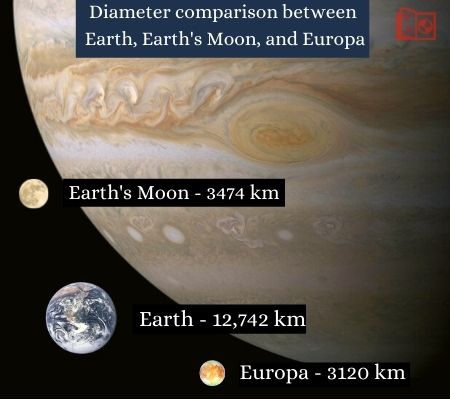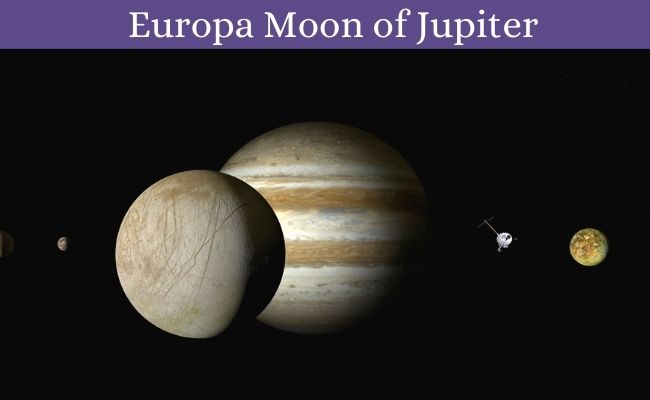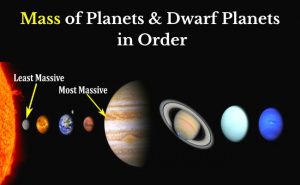Europa is the moon of Jupiter and comes in the category of Galilean moons. It is the sixth closest moon to Jupiter Planet with an orbital distance of around 671,000 kilometers.
Europa moon is the smallest Galilean moon (Ganymede, Callisto, Io, and Europa) but the fourth-largest moon of Jupiter.
This moon was named after “Europa” who was the lover of Zeus, also after whom the continent Europe is named. The Moon Europa is just a little smaller than our earth’s moon.
Here in this article, you will learn about Jupiter’s Moon Europa with its facts and much other related information like Life on Europa, Europa Moon Temperature, Gravity of Europa, Distance from Earth, Size of Europa, and many more.
Europa Moon Facts
⇒ The Jovian moon Europa was discovered by Galileo Galilei in 1610 with all other Galilean moons.
Must Read:- Jupiter Moons: Facts, Names, Numbers & List
⇒ According to a hypothesis, this moon may have a water ocean beneath its surface. And this hypothesis developed because Europa Moon has the smoothest surface than any other known solid object in our solar system. It does not have mountains and craters. But according to some estimations, Europa’s equator may have some icy spikes of around 15 meters.
⇒ Because of the water ocean present beneath its surface, Jupiter Moon Europa may have extraterrestrial life.
⇒ Europa’s surface looks something different than other objects in our solar system. Its surface has dark streaks and lines (Latin: Lineae) throughout the whole moon. It seems like a crack on the surface of Europa Moon. According to scientists, these lines (cracks) originated from the eruptions of warm ice on its surface.
⇒ Like other famous moons of our solar system, Europa is also a tidally locked moon. A tidally locked moon means, it always faces the same face towards its planet while orbiting. It means the moon’s revolution and orbital periods are the same (one day and one year are the same on this moon).
Must check:- Total Number of Moons in the Solar System
⇒ According to scientists, there is liquid water under the surface of Europa. Its surface is made of the icy crust and beneath it, there is a subsurface ocean throughout the whole globe. Though Europa’s surface temperature is quite low that has made its crust solid-icy. But the under-surface water ocean remains liquid because of the tidal heating effect.
⇒ The surface of Europa is in the color of reddish-brown. It may be because Europa’s surface is rich in salt such as magnesium sulfate. Also, some other materials are also present to give it reddish colors such as Sulfuric acid hydrate and other sulfur compounds.
⇒ The Europa (moon) distance from earth is around 595 million kilometers. As it is the moon of Jupiter, a moon of any planet could not be so far from its host planet. So, the average distance of this moon from earth would be around the same as the host planet’s distance. The orbital distance of this planet from Jupiter is around 671,000 kilometers.
⇒ With help of the Hubble Space Telescope (HST), in 1995 scientists found a thin atmosphere that is mostly made of molecular oxygen (O2) and water vapor. The pressure of this atmosphere is almost 10-12 times in comparison to earth. Same in 1997, the Galileo spacecraft confirmed the presence of a little atmosphere on Europa.
Read about:- What are the 5 Layers of the Atmosphere in Order?
Europa Size
The size of the Europa is around 3120 km (~970 mi) in diameter which makes it the fifteenth-largest object in our solar system. It is the smallest in the Galilean moons (Galilean Moons in order of size – Ganymede, Callisto, Io, and Europa) but the sixth-largest moon in our solar system.

While comparing with the earth’s moon it is just slightly smaller (earth’s moon diameter – 3474 km).
Europa Moon Temperature
The moon Europa is quite far from the sun. It gets very little radiation from the sun which makes it very cold-surface in temperature. The surface of this moon is made of an icy solid crust just because of its lower temperature.
The average surface temperature on this moon is 102 K (−171 °C). The lowest temperature recorded on the poles is almost 50 K (−223 °C).
Life on Jupiter’s Moon Europa
Scientists believe Europa has a subsurface ocean under its solid icy crust. These oceans are in form of totally liquid water. The presence of liquid water on Europa Moon may lead to extraterrestrial life.
There is no evidence of life on the Moon Europa, but this moon exists in a location of the solar system that may lead to potentially habitable. Life on Europa Moon can exist under its deep icy ocean.
Related:-
- Ganymede Moon: Largest Moon of Jupiter
- 10 Facts about Titan Moon Largest of Saturn
- Triton Moon Facts/ Size/ Temperature/ Atmosphere?




